|
|
Gainsborough

|
|
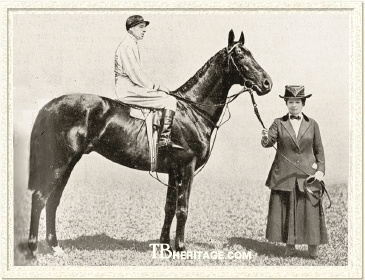 |
|
|
The word "thoroughbred" is derived from the breeding of superior race horses in England in the 1600s and 1700s. It was -- and still is -- a term used to describe the horse's ancestry as made up of purely the best running horses, and only the best. The Stud Book came later, in an attempt to define what made a horse "thoroughly bred." Many theories have been put forth as formulas in breeding a great thoroughbred, but few have delivered on the promise on a regular basis. Research into equine heredity has helped determine that the oldest breeding method remains the most effective:› Breed the best to the best and hope for the best.
In England, the best has been synonymous with winners of the classic races, the Derby, the Oaks, the St. Leger, the 1,000 Guineas and 2,000 Guineas. So it was, that Lady James Douglas sent the Oaks winner Rosedrop to St. Leger winner Bayardo and got a fine looking bay colt in 1915 that she later named Gainsborough. Gainsborough won the English Triple Crown, fulfilling any breeder's dream. That Gainsborough went on to become one of the most influential sires of the twentieth century is a tribute to the breeding ideal. Sometimes breeding the best to the best and hoping for the best really pays off.
Lady James Douglas
Lady James Douglas was born in 1854 as Martha Lucy Hennessy, a daughter of Frederick Hennessy, a member of the Irish family which had made a fortune in France in the Cognac business. In 1872, she married her first cousin, Richard Hennessy of Chateau de Bagnolet, and had five children. Widowed in 1885, Margaret married Lord James Edward Sholto Douglas, the fourth son of the Marquess of Queensberry in 1888.
Lord James Douglas was from a notable family with tragic overtones. His father, Lord Queensberry, died in a suspicious shooting incident that may have been suicide. His brother Francis, was part of the team that made the first successful ascent of the Matterhorn in Switzerland, only to fall to his death on the descent in 1865. His brother, John, became the ninth Marquess of Queensberry, and established the famed rules of boxing, which are named for him. Lord James, who had exhibited symptoms of alcoholism and dementia, killed himself in a London hotel in 1891.
In 1910, Lady James Douglas, in her mid-fifties, purchased farmland associated with Harwood Lodge, near the village of Woolton Hill, in Hampshire. With the help of an advisor, the legendary trainer John Porter, she developed Harwood Stud, a few miles from Porter's training yard at Kingsclere, also in Hampshire. The stud's initial purpose was to sell high quality yearlings, so Lady James Douglas went about collecting top class mares that would produce a commercial foal crop. In 1912, the first broodmares were put in production.
Oaks Winner
One of the early acquisitions was Rosedrop, winner of the 1910 Oaks Stakes and Great Yorkshire Stakes, as well as placing third in the 1,000 Guineas to Winkipop. Sold for 4,500 guineas at the dispersal of her owner, Sir William Bass in 1911, she became the property of Alfred Cox, from whom Lady James had purchased her. Rosedrop was a mare that had a hard time finding a permanent home. She produced the Bayardo filly La Tosca in 1914. After producing Gainsborough in 1915, and no foal in 1916, she was sold at the 1916 December Sale in foal to Polymelus for 2,300 guineas to J.W.A. Harris on behalf of Sir John Scott. There's no record that she produced a live foal by Polymelus in 1917.
In 1922, at the Newmarket July Sales, Rosedrop was sold for 550 guineas to Walter Salmon of Mereworth Stud in Kentucky. She was in foal to Somme Kiss at the time, and again, there is no record that she produced a live foal in 1923. She was the dam of Mere Play, a 1925 colt by Fair Play. Her next and last foal of record was Rosern, a filly by Mad Hatter born in 1927, who produced the good handicapper Sunglow (by Sun Teddy). Sunglow sired› champion Sword Dancer, whose son, champion Damascus continues the Teddy male line into modern pedigrees. This gives Rosedrop a unique connection to two different male lines, through Gainsborough (sire of HYPERION and SOLARIO) and Damascus. Since Rosedrop only has six foals of record from 1914 to 1927, it's a safe presumption that she had issues conceiving or maintaining a pregnancy, which may have been why she changed hands so often.
The Bloodstock Breeders' Review of 1916 describes her as "a robust stamp of a mare with flaxen mane and tail." The photo that accompanies the text shows a rather plain-headed mare with a convex profile, all the more visible due to a blaze that broadens high on her forehead and low on her nose. Photos of her in racing trim show a filly very on the leg with a short, thin, neck. She's got a great shoulder and hindquarter but appears slightly back at the knee and noticeably upright through her pasterns.
Bayardo
Rosedrop's first matings were with Bayardo (1906 by Bay Ronald - Galicia by Galopin), an outstanding race horse bred and raced by Mr. Fairie, the nom-de-course of Alfred W. Cox. Bayardo raced three years, and won 22 of 25 starts, most with such ease and confidence and under high weights that he is considered one of the best racehorses of the twentieth century. Undefeated at two, he won the St. Leger, Eclipse and Champion Stakes at three, and the Ascot Gold Cup at four. He retired to stud at trainer Alec Taylor's Manton Stud in Wiltshire.
Bayardo was the leading sire in Great Britain in 1917 and 1918, due in large part in 1917 to his son Gay Crusader, who won a wartime Triple Crown and was a truly great racehorse. The 1918 title was due to Gainsborough. Bayardo died regrettably young, in 1917, at 11 years, from paralysis in his hind legs due to a blood clot. His best runners were Gay Crusader, Gainsborough, and the Oaks winner Bayuda. He got very little else of note on the racecourse but a few of his daughters were good producers, the dams of Beresford, Saucy Sue, Swift and Sure and Pladda.
Rosedrop produced her second foal, a colt by Bayardo, on January 24, 1915 at Harwood Stud. This was Gainsborough, given that name later by his breeder who liked the sound of the word when she read it as a town near Lincolnshire. Gainsborough was a good looking foal, with Bayardo improving on Rosedrop's faults, providing a nicer, lengthier neck, and more elegant frame. Although never a big horse (he matured at 15.3 hands), Gainsborough was very well made, extremely handsome, and athletic, but there was something about him as a youngster that made his breeder hesitant about selling him.
At the 1916 Newmarket yearling sales, Lady James put a hefty reserve of 2,000 guines on the Bayardo - Rosedrop colt. This was during wartime, and all racing had been suspended except at Newmarket, and maintained there for the explicit purpose of maintaining some breed standard of performance for the affected foal crops. The market wasn't strong, but 2,000 guineas was a high reserve under any circumstances. Clearly the reputation of Bayardo was still strong, although his first few two crops, foals of 1912 and 1913, hadn't produced a stand out runner yet. That one was still waiting in the wings as a two-year-old in 1916 and his name was Gay Crusader. The Rosedrop colt went through the ring unsold at 1,800 guineas.
An agent for American owner/breeder John Sanford of the Hurricana Stud, in Amsterdam, New York, had seen the colt and opted out on his client's behalf, believing that he was too heavy topped, which presented soundness risks. When Sanford heard of the final hammer price and that he was not the new owner, he instructed his agent to pursue the colt at their original appraised value of 2,000 guineas. The agent went to Lady James with the offer, but she turned him down. Shortly after the sale, the representative of another wealthy American, Joseph E. Widener, arrived on the scene, only to realize he'd missed his opportunity as well, his train being delayed by foggy weather. He offered 2,500 guineas to get the colt. Lady James conferred with Alec Taylor, who had trained Bayardo, and who surprisingly recommended she keep his son, even at that price.
The colt, now known as Gainsborough, was sent to her trainer, Colledge Leader at his yard in Newmarket, but shortly thereafter, Leader joined the war effort and Gainsborough was transferred to Alec Taylor's facility at Manton, also where Bayardo held court, and where the newly turned three-year-old Gay Crusader was warming up for a championship year. Here, he engaged the staff with his intelligence and excellent temperament. Comparisons to his sire were inevitable and always favorable.
Gainsborough on the Turf
Although still on the small side, Gainsborough had grown into an impressive individual but still had some maturing to do. He debuted in the Thurlow Plate at Newmarket on July 31, 1917, finishing fourth in a field of 21 juveniles going five furlongs, behind Giant Killer, Merovigian and Herself. The feature that afternoon was the New Derby, a substitute race for the classic run during wartime at Newmarket and this year's renewal was won by his stablemate Gay Crusader. Gainsborough's next start was on August 28 for the Ramsey Plate, also five furlongs and a little more at Newmarket. He moved up a place, finishing third behind Violinist and Scatwell, who appeared better in defeat since he'd given ten pounds to the two that beat him.
In his third start, on September 12 in the Autumn Stakes, third choice Gainsborough finally shook himself loose and won, given an extra furlong, beating the classy filly Freesia by two lengths, with Violinist third. On the Free Handicap, Gainsborough was the second high weight at 122 pounds behind the lightly raced Scatwell (126 pounds) who had impressed when conceding Violinist and Gainsborough ten pounds in the Ramsey Plate.
Classic Winner
Gainsborough's season debut as a three-year-old in 1918 was in the Severals Stakes, five furlongs at Newmarket against older horses. It was an unlikely prep for the Guineas, but there he was on a miserable spring day with a course rated "heavy" and he ran a dull race to finish off the board behind the victor Syndrian. As odd as that prep seemed, Taylor had Gainsborough rounded in to form perfectly for the 2,000 Guineas two weeks later. The Bayardo colt toyed with Somme Kiss throughout, and pulled off to win by a length and a half, with Manton stablemate Blink six lengths in arrears in third. The finish was a popular one because Gainsborough was the first classic winner ever bred, owned and raced by a woman.
The New Derby, still a wartime substitute race run at Newmarket, was an easy piece of work and Gainsborough won by a length and a half over Blink, with Treclare third. Again, this was a landmark win, as he was the first Derby winner bred and raced by a woman. Two previous Derby winners had been bred by women (Sainfoin, in 1890, bred by Her Majesty Queen Victoria; and Volodyovski in 1901, bred by Lady Meux) but in both cases, the horses were either sold or leased and raced for new (male) owners.
In the Newmarket Gold Cup, a substitute for the Ascot Gold Cup, Gainsborough faced older horses going a little over two miles, and won "cleverly if not comfortably" beating Planet and Dansellon, the entire field of three. Only four chose to face Gainsborough in the September Stakes, the St. Leger substitute race at Newmarket, in which he romped in by three lengths over My Dear (that season's Oaks winner) and Prince Chimay, the top three all coming from Alec Taylor's yard at Manton.
Gainsborough's win in the September Stakes marked his victorious completion of the "Triple Crown" of English racing, the thirteenth to do, and duplicating the feat of his older kinsman Gay Crusader the previous year. The crown for both has been put under the microscope because of the wartime restrictions placing all three events at Newmarket, instead of the Derby's home at Epsom and the St. Leger's home at Doncaster. Their Triple Crown titles are somewhat tarnished as a result. Under any circumstances, Gay Crusader is considered a thoroughly top class, outstanding runner, with Gainsborough perhaps not in the same league as a racehorse, but he far exceeded Gay Crusader as a stallion.
After Gainsborough's win in the September Stakes, what was looking like a royal procession suddenly came to a bump in the road in the Jockey Club Stakes, at a mile and three quarters. Stablemate Prince Chimay ran the race of his life, caught Gainsborough's jockey unawares with a rush and won by a length, with Gainsborough closing the gap with every stride. The victory appears to have been as much as surprise to trainer Taylor as it was to anyone else but Prince Chimay's pilot Otto Madden, who knew his stablemate/opponent's running style and used it to his advantage.
That closed out Gainsborough's sophomore season. Although apparently sound, he did not race as a four-year-old but still did not enter stud until a year later. It's possible he was in training but encountered a problem that prevented a return to competition, or, being only a four-year-old in 1919, was considered by his owner to be too young to stand as a stallion and given another year to fully mature.
Gainsborough in the Stud
Whatever the reason, Gainsborough made his first season as a stallion in 1920 at Manton alongside Bayardo's other Triple Crown winning-son Gay Crusader, both standing at 400 guineas. Bayardo had died at Manton in 1917 and either or both of his sons could have been seen as heir to the throne. After that first season, it's possible that Lady James Douglas felt that Gainsborough would be better received standing out of the shadow of Gay Crusader, because in 1921, an advertisement places him at stud at Old Dalby Hall, Melton Mowbray. In 1922, Gainsborough was noted as returning to stand at his birthplace, Harwood Stud, Newbury, where he lived out his days.
Lady James Douglas lived at Harwood, enjoying the quiet life and routines of a working horse farm. Her biography on the website for National Horseracing Museum at Newmarket notes "She lived in a house overlooking the stables and was often pleased for the mares and foals to be led to her front door for inspection. She was unfazed if a youngster cavorted across her immaculate flower beds. 'Let him go. I pay gardeners to keep the place tidy,' she would remark."
The year following Gainsborough's Triple Crown, Lady James Douglas won a second classic, this time with the homebred filly Bayuda (1916 by Bayardo - Jessica by Eager), winner of the 1918 Cheveley Park Stakes and 1919 Oaks Stakes. Although not a great broodmare herself, through her daughter Hajibi, Bayuda became the tail-female ancestress of the important speed sire Sharpen Up. Another classic product of Harwood Stud was the 1930 Oaks winner Rose of England, which had sold as a yearling for 3,100 guineas to Lord Glanely, who raced the classic filly. Rose of England was later the dam of St. Leger winner Chulmleigh, Newmarket Oaks winner Fairie Queen, and the good two-year-old British Empire, a pivotal sire in Argentina.
In 1940, Lady James Douglas, already in failing health at the age of 86, sold the broodmare band with the exception of one old favorite, Tilly (1918). The Harwood Stud property was bought by Herbert Blagrave, with the condition that the aging Gainsborough have a comfortable home there for the rest of his days. The 25 year old stallion was already in decline. He covered only eight mares in 1940, all in foal, but in 1941, bred only one successfully, old Tilly, who produced a colt the next year, named Fame, who was Gainsborough's last foal. Lady James died in January of 1941 at the age of 87. Gainsborough lasted a few more years, dying on June 5, 1945 and he was buried on the property where he was born 31 years before. The new owner, Mr. Blagrave, had already renamed the stud in his honor, Gainsborough Stud, the name by which it is still known today.
Gainsborough was successful from the start. His first small crop included the good two-year-old BLUE LAKE. His second crop included St. Leger and Ascot Gold Cup winner SOLARIO, and there was a good one in every crop for many years. He sired at least 36 stakes winners, led by one of the greatest racehorse/sire combinations of the Twentieth Century -- HYPERION. In all, Gainsborough sired five classic winners: HYPERION (Derby, St. Leger), SOLARIO (St. Leger, Ascot Gold Cup), SINGAPORE (St. Leger), ORWELL (2,000 Guineas), and SILVANA (Italian Oaks), as well as juvenile high weight COSTAKI PASHA, and other good runners BOBSLEIGH, ARTIST'S PROOF and WINTERHALTER. He was consistently among the leading sires in Great Britain, in the championship spot in 1932 and 1933, and second in 1931.
Best Offspring
Gainsborough's best and most influential offspring was HYPERION (1930 chestnut colt out of Selene by Chaucer) who came along ten years into Gainsborough's very successful stud career. Bred and raced by Lord Derby, HYPERION was a very popular runner, often perceived as an underdog because he was so small compared to his rivals. He compiled a record over three years of 13 starts, nine wins, one second, two thirds and one fourth. At two he won three of five starts including the Dewhurst Stakes, New Stakes (setting a new course record for five furlongs at Ascot), and Prince of Wales's Stakes (actually a dead heat with Nancy Stair), and third in the Boscawen Post Stakes. He was rated fourth on the Free Handicap. At three, HYPERION dominated his generation with wins in the Chester Vase, Derby, Prince of Wales's Stakes, and St. Leger. At four, he won the March Stakes and Burwell Stakes; was second in the Dullingham Stakes and third in the Ascot Gold Cup.
|
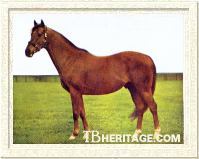
Hyperion
| |
As a stallion, HYPERION was a genetic dynamo. He was the leading sire in Great Britain six times (1940, 1941, 1942, 1945, 1946, 1955) and the leading broodmare sire twice. His best runners included Aureole, Owen Tudor, Sun Chariot, Godiva, Hycilla, Sun Stream, and Pensive. He had many important stallion sons besides Aureole and Owen Tudor, including Heliopolis, Khaled, Alibhai, Gulf Stream, High Hat, Hornbeam, and Stardust. Stardust's son Star Kingdom established a dynasty in Australia and New Zealand where this male line still thrives. HYPERION died in December of 1960 at the age of 30. |
HYPERION was certainly the best of the Gainsboroughs, but SOLARIO was not far behind, and was the one of the first of his young sire's progeny to draw attention. SOLARIO (1922 brown colt out of Sun Worship by Sundridge) came along in Gainsborough's third foal crop. He was bred by Lord Dunraven and foaled on April 26 at his owner's Fort Union Stud in Ireland. He and his dam were then returned to Harwood Stud, where Sun Worship was bred back to Gainsborough to produce his full sister, the high class producer Imagery, foaled the next year. The Gainsborough colt was offered as a yearling at the Doncaster sales and brought 3,500 guineas from Sir John Rutherford, one of the top four lots offered at the sale.
SOLARIO was a good two-year-old, winner of the Exeter Stakes, second in the Middle Park Stakes, and third in the Chesham Stakes in his debut. He was rated second behind the high weight Picaroon and above the next year's Guineas and Derby winner Manna. At three, he began the season with a loss to Picaroon in the Craven Stakes at a mile, then fourth to Manna in both the 2,000 Guineas and Derby. In the Derby he had an excuse, however, being left behind when the starting tape wrapped around his legs, and delayed his departure, making his fourth place finish less of a disgrace. SOLARIO found his good form, beating Manna in the Ascot Derby, and the older horses Obliterate and St. Germans in the Princess of Wales's Stakes at Newmarket, both races at 12 furlongs. Trained to perfection by Reginald Day for the St. Leger, SOLARIO ran off to win the classic by three lengths over Zambo and Warden of the Marches, although Manna was never a factor, and in fact had broken down in the running.
At four, SOLARIO proved his staying greatness, winning the Coronation Cup by an astounding 15 lengths. After this, Jack Joel offered Rutherford 75,000 pounds for the colt, which was refused, as was the 100,000 pounds refused from the Aga Khan. SOLARIO next won the Ascot Gold Cup by three lengths. He was upset in his final race, the Jockey Club Stakes, when Foxlaw beat him by a neck, which was, " a victory that was greeted with stunned silence." SOLARIO was actually disqualified and placed last of the five runners for "bumping and boring." He retired with a record of 12 starts, six wins. |
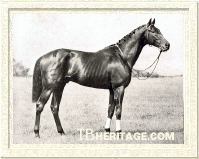
Solario
| |
An even better looking horse than his sire, Gainsborough, SOLARIO was an unmarked brown of elegant design, built in the model of the perfect stayer, with high withers, long legs and a short back. He retired to Terrace House Stud in Newmarket at 500 guineas, the highest stud fee in the land. His owner, Sir John Rutherford, died in 1932 and SOLARIO was offered in his dispersal at the Newmarket July sale that year. Amidst fear that he would be snatched up by a wealthy American syndicate, bidding was contentious and a syndicate headed by Lord Glanely won him at 47,000 guineas, a new record price for a horse at auction. He was returned to stud at Terrace House where he died in 1945. |
SOLARIO proved a very successful, desirable stallion, and was the leading sire in 1937, the year his Mid-Day Sun won the Derby. He sired a second Derby winner in Straight Deal, also 1,000 Guineas and Oaks winner Exhibitionist, Irish Derby winners Dastur and Raeburn; Irish Oaks winner Silversol, and other prominent stakes runners Sunny Devon, Tai-Yang, Solar Flower, Dhoti, and Sind. SOLARIO was the Leading Broodmare Sire in 1943, 1949 and 1950, and the broodmare sire of Solar Slipper, Indiana, Cavan, Royal Charger, Tessa Gillian, Sunny Boy, Ridgewood, Krakatao, Hindostan, Ratification, Tehran, and Escamillo. His name in pedigrees indicates high quality and usually great stamina.
A few years after SOLARIO, Gainsborough was represented by another top class stayer in the form of SINGAPORE (1927 bay colt out of Tetrabbazia by The Tetrarch). Bred by Sir Alec Black of Compton Park Stud, he was sold as a yearling for 12,500 guineas to Lord Glanley.
|

Singapore
| |
SINGAPORE was unraced at two, and at three didn't win until his fourth start, the Sandringham Foal Stakes at 10 furlongs, before which he had placed in the Greenham Plate and ran unplaced in the 2,000 Guineas and St. James's Palace Stakes. Second in his next start, the 12 furlong Grantwicke Stakes to Ramses the Second, SINGAPORE found his niche in the St. Leger, which he won from Parenthesis and Rustom Pasha. Rustom Pasha took revenge in the Champion Stakes, which was too short for SINGAPORE, who ran unplaced. At season's end, however, SINGAPORE was co-high weight three-year-old with Press Gang. At four, SINGAPORE won the Doncaster Cup over two and a quarter miles beating Brown Jack, and was second in the Ascot Gold Cup by a whisker to Trimdon. |
SINGAPORE had little success at stud standing at Exning House Stud in Newmarket. His son Chulmleigh won the 1937 St. Leger, and Arco won the 1942 Derby Italiano. A daughter, Indian Call produced the good horse Ballymoss; another daughter, Empire Glory was the dam of the important broodmare Noorani; a third, Skerweather, produced Royal Challenger. In 1942, Singapore was offered at auction and could only attract a bid of 500 guineas, and was ignomiously shipped to Brazil, age 15.
Although Gainsborough's forte appeared to be stamina, he sired more precocious runners with speedier mares. His son COSTAKI PASHA (1926 bay colt out of Cos by Flying Orb) was bred and raced by the Aga Khan and foaled out of one of that owner's brilliant first runners and foundation mares, Cos. She also produced the Highweight Two-Year-Old Filly Mrs. Rustom, as well as the high class Rustom Pasha and Hilla. |
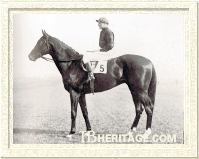
Costaki Pasha
| |
COSTAKI PASHA started four times at two, winning three, the Chesham Stakes, Hopeful Stakes and Middle Park Stakes, and second in the Berkshire Foal Plate. He was the joint high weight colt with Mr. Jinks, rated one pound behind the brilliant filly Tiffin on the Free Handicap. He faded as the rest of the crop caught up with him, with four starts and one minor third at three. At four, he salvaged a win in the Cork and Orrery Stakes, and second in the King George Stakes to Stingo. COSTAKI PASHA went to stud in France and then moved on to India, siring nothing noteworthy.
. |
|
Another of the more precocious Gainsboroughs, the brilliant ORWELL (1929 bay colt out of Golden Hair by Golden Sun), was bred on a similar cross as SOLARIO, whose dam was by Sundridge, also the sire of Golden Sun. He was bred in Ireland by Lord Furness and raced by Washington M.G. Singer. |
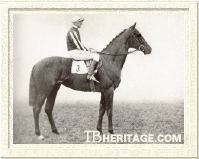
Orwell
| |
ORWELL, who began racing unnamed, as "the Golden Hair colt" was the co-high weight at two with Mannamead after wins in the National Breeders Produce Stakes, Champagne Stakes and Middle Park Stakes. At three, ORWELL returned with facile wins in the Chesham Stakes and 2,000 Guineas, the latter by two lengths over Dastur (by SOLARIO) and Hesperus. ORWELL was star quality up to this point and was being covered with superlatives before he stunned the world by failing to stay in the Derby, finishing a tiring ninth in a race won by April the Fifth, with Dastur second. He regained some of his glamour by winning the Great Foal Stakes, and was the surprising favorite in the St. Leger, but he again failed to stay and finished seventh behind the winner Firdaussi. |
ORWELL retired to stud at King Edward's Place, Wanborough, near Swindon but was met with limited success. He sired Irish Derby winner Rosewell, the good French filly Buena Vista and the broodmare East Side II, the third dam of the top runner and sire Irish River.
Gainsborough's fifth classic winner was SILVANA (1935 bay filly out of Pastorella by Sansovino). She was the Champion Two-Year-Old Filly in Italy, winning the Premio Bimbi and third in the Criterium Nazionale (to a nice colt named Nearco); and at three, won the Oaks d'Italia, following in the footsteps of her half-sister Amerina (by Apelle), who won the Oaks d'Italia the previous year.
The great French breeder Marcel Boussac used Gainsborough on occasion, and the best product proved to be GOYESCAS (1928 bay colt) out of his foundation mare Zariba, by Sardanapale), who also produced the two-time Arc winner Corrida and champion and leading sire Goya II. |
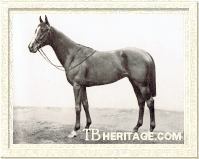
Goyescas
| |
At two, GOYESCAS won the Chesham Stakes and placed second in the Middle Park Stakes to Portlaw. At three, he won the Champion Stakes, as well as running second in the 2,000 Guineas and Eclipse Stakes. At four, the hard-working Gainsborough colt won the Hardwicke Stakes, and put in several classy performances when second in the Coronation Cup (by a half length to Salmon Leap), Eclipse Stakes (by half a length to Caerleon), and Prix de l'Arc de Triomphe (by half length to Motrico). At five, GOYESCAS dominated the older male division in France with victories in the Prix Edmond Blanc, Prix Boiard, Prix des Sablons, Prix d'Hedouville, and Prix d'Ispahan. He came to an unfortunate end, breaking an ankle in the Prix du President de la Republique, although his death that year (1933) was attributed to "cerebral congestion," an archaic term for heat stroke.
|
GOYESCAS never got a chance at stud, but Gainsborough's son TOURNESOL (1922 bay colt out of Soliste by Prince William) made up for that loss to some degree. Although not a first class runner, he was tough and scored six wins from 24 starts including the Princess of Wales's Stakes, Zetland Plate and Duchess of York Plate. Sent to stud in Japan, he became the leading sire in that country five times. His progeny include Japanese Derby winners Hisatoma, and Kumohata, the first native-bred leading sire in Japan, where he was leading sire six times.
EMBOROUGH (1932 chestnut colt out of Embarras de Richesse by Phalaris) was another Gainsborough son who was a useful stakes winner - winner of the Liverpool Autumn Cup and Manchester Cup - and became a leading sire elsewhere. Exported to Australia on the same ship with Midstream, EMBOROUGH sired the champion Bernborough, who led him to the leading sire championship in Australia for the 1945/1946 season.
Gainsborough's best daughter was GAINSBOROUGH LASS (1934 bay filly out of Golden Hair by Golden Sun), a full sister to the brilliant ORWELL. Bred by Lord Furness, she was second in the Gimcrack Stakes at two, and she was one of the best fillies of her generation at three, winning the Column Produce Stakes and Coronation Stakes, and third in the 1,000 Guineas Stakes (won by SOLARIO'S daughter Exhibitionist). GAINSBOROUGH LASS became an influential broodmare, as dam of the stakes winners Glass Slipper (by Windsor Slipper), Lincoln Imp (by Nearco) and Admiral's Luck (by Precipitation). Along with Admiral's Luck, she had three other sons - Knight's Romance (by Royal Charger), Pride of Kildare (by Royal Charger) and Resurgent (by The Phoenix), all of which became good sires in New Zealand.
|
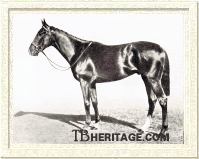
Bobsleigh | |
Gainsborough's other top stakes winners included Coronation Cup winner WINTERHALTER, Park Hill Stakes winner GAINLY, Yorkshire Oaks winner STAR OF ENGLAND, Prince of Wales's Stakes and Newbury Autumn Handicap winner LE VOLEUR, Dewhurst Stakes winner GRACE DALRYMPLE, Durban Gold Cup winner ARTIST GLOW, AJC Metropolitan Handicap winner MURILLO, as well as BOBSLEIGH and ARTIST'S PROOF who show up in pedigrees as broodmare sires. |
Legacy
Gainsborough's best son as an influential stallion was undoubtedly HYPERION who was the leading sire in Great Britain and Ireland six times, and owned several leading broodmare sire titles as well. SOLARIO was a good second, the leading sire in 1937, and a leading broodmare sire on several occasions. TOURNESOL was a five-time leading sire in Japan, and EMBOROUGH was a leading sire in Australia. Beyond that, few of Gainsborough's sons did well in Europe, and generally speaking, had more influence as broodmare sires than sires.
Daughters of Gainsborough, on the other hand, were very important. MAH MAHAL produced Derby winner and American leading sire Mahmoud and granddam of Arc winner Migoli. UNA CAMERON produced 2,000 Guineas winner Cameronian. PAINTED VALE was the dam of 1,000 Guineas and Oaks winner Musidora.
Gainsborough was born a prince, a son of classic winners Bayardo and Rosedrop, and lived up to his heritage, winning the war-time English Triple Crown. A beautiful horse in every respect, he passed on this excellence as a sire, and left a breed influence of the highest class and quality.
--Anne Peters
|
|
|
|

